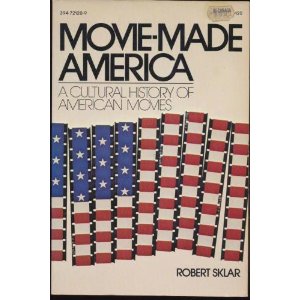 |
| Movie-Made America by Robert Sklar |
I came across this interesting piece from Movie-Made America: A Cultural History of American Movies, in which author Robert Sklar talks about a fairy-tale aspect of acting (being “discovered”), the patriarchal foundation of casting, and the behind-the-scenes women of the 1910s and 1920s . I’ve added some links to the original text for further reading.
. I’ve added some links to the original text for further reading.
In the World War I era–an unsettled period when late-Victorian mores persisted side by side with an emerging image of a “new woman”–it could only have been disconcerting to respectable Americans to see photographs of determined young women in the ankle-length dresses, high-button shoes and broad-brimmed hats standing in long lines outside a Hollywood casting office. The American middle class had only just begun to regard movies as something other than immoral trash for working-class people; and suddenly their daughters were packing up and leaving home to seek their fortunes in the movies.If they had to go, the least one could do was give them sound advice, most of it intended to be discouraging. A girl should plan to have enough money to survive for a year without additional income; authors of advice books and articles for the movie aspirant set the minimum figure at $2,000. She should have resources enough to be able to acquire her own wardrobe, since extras in those days had to supply their own outfits for scenes of contemporary life. She should consider what abilities she possessed and perhaps direct her ambitions to other interesting work in motion pictures.Studios needed talented dress designers, set decorators, film cutters, all jobs that were open to women. In fact, the motion-pictures studios in the 1910s and 1920s gave more opportunities to women than most other industries, far more than they ever did again. Many of the leading scenario writers were women, among them Anita Loos, June Mathis, Frances Marion and Jeanie Macpherson. Lois Weber was a well-known director and independent producer, and Elinor Glyn, Dorothy Arzner and other women directed films during the 1920s. Women were occasionally found in executive positions in Hollywood producing companies. And if a woman possessed none of these talents, there were always jobs as secretaries, mail clerks, film processors, and in other modest but essential roles in the making of movies.But what women wanted was to be actresses. They could see that other girls, many still in their teens, without acting experience, were making it. Why not they? But no one informed them that a fair share of the young girls with film contracts were “payoffs,” as Colleen Moore called them: players who were hired as a favor to influential people or to pay back a favor they had done the studio. Moore got her start because her uncle, a newspaper editor, gave D.W. Griffith help in getting his films approved by the Chicago censorship board, and Griffith repaid him with a contract for his niece. In Silent Star, Moore reports that Carmel Myers, Mildred Harris (a bride at sixteen to Charlie Chaplin) and Winifred Westover, who began acting as teen-agers, were all “payoffs” in similar ways.
